|
Broadly speaking, there are two kinds of jazz films
—documentary records of particular jazz performances and
narrative films that incorporate jazz in some fashion, in
their soundtrack scores and/or in their stories. But in some cases,
identifying which films belong in which category is simply a matter
of personal taste. Consider, for instance, Black and Tan and
St.
Louis Blues, two landmark jazz shorts directed in 1929 by Dudley
Murphy—-a fascinating figure who straddled the avant-garde and the
mainstream, having both collaborated with Fernand Léger on Ballet mécanique and Paul Robeson on
The Emperor Jones and directed several
Hollywood pictures, and who’s been receiving some belated
recognition lately thanks to Susan B. Delson’s excellent biography,
Dudley Murphy: Hollywood’s Wild Card (University of Minnesota Press,
2006). I would argue that Black and Tan, which stars Duke Ellington,
is important chiefly as a narrative film, whereas St. Louis Blues is
mainly important because it features the only appearance and
performance on film by the great blues singer Bessie Smith. (Both
are available, incidentally, on
Hollywood Rhythm Vol. 1: The Best of
Jazz and Blues, along with ten other shorts, most of them from the
30s and most of them released by Paramount. Black and Tan is
unfortunately included in the Raymond Rohauer rerelease version,
which substitutes its own distracting version of the credits while
changing the film’s title to Black and Tan Fantasy.)
It’s also worth pointing out that narrative features such as
Round
Midnight and
Bird also include some documentary records of jazz
performances, though the status of these performances is somewhat
problematical. The former film has a wonderful lead performance by
Dexter Gordon as an aging and ailing jazz musician; but Gordon was
aging and ailing himself when he made the film, and his playing is
far from his best. So even though much of the music was recorded
live, it isn’t worthy of its star. And
Bird combines Charlie Parker
solos with accompaniments by musicians that were recorded decades
after Parker’s death; these ahistorical combos are pantomimed by
Forest Whitaker and other actors onscreen.
I’m still waiting for my all-time favorite narrative
film involving jazz to be released on DVD—-Charles
Burnett’s sublime, 12-minute When it Rains (1995), to be
included in a Burnett box currently scheduled to come out
from Milestone in August. And maybe I’ll eventually get around to
writing a list of recommendations for that category. But for the
time being, it seems more useful to cite some favorite jazz
performances available on DVD. Some of these I’ve recommended partly
for special reasons—-period funk (The Small Black Groups), exciting
camerawork (Jazz on a Summer’s Day), or interactive features (Trane Tracks). But in most cases, I’ve picked them for the quality of the
music they contain. Sometimes they’re live recordings and sometimes
(in many of the early examples) they’re mimed to playback.
Several of these DVDs have been acquired from European sources, and
one facet of the first two of them worth noting is that they’re
two-sided, all-region discs that play PAL on one side, NTSC on the
other. One special advantage of this is that if you acquire a disc
that has some technical glitches (especially inconvenient if you’re
acquiring stuff from abroad) and you have a multiregional player,
you can always flip the disc over and play the same tracks you’re
having trouble with on the other side. (This is precisely what I did
recently with
Nat ‘King’ Cole: Soundies and Telescriptions.)
A few more caveats: (1) It’s a matter of personal preference rather
than any sort of objective judgment that I’m especially interested
in piano players, that my taste mainly runs to post-swing, and that
I’m generally more partial to Ahmad Jamal and Keith Jarrett playing
standards than to these gifted pianists playing their own tunes.
Also, I prefer hearing Jarrett in a trio setting than solo. (2) The
stock of great jazz performances on film or video tends to be
finite, so a lot of the same footage turns up in a good many
documentaries; after awhile, you start to recognize them right away,
like old friends. (3) You should also be warned that some the
releases I’m recommending can’t always be trusted when it comes to
listing their own contents accurately.
(NOTE: CLICK ON
TITLES, COVERS OR UNDERLINED TEXT FOR LINKS)

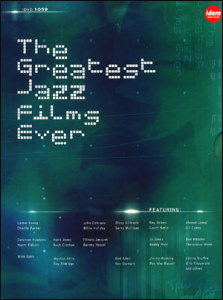 |
1)
(The Greatest Jazz Films Ever. A prime instance of what I mean is
this two-disc set originating from Spain, which very nearly lives up
to its title, but can’t get some of the basic facts about its own
treasures straight. No dates are given anywhere in this package, so
let me begin with some basic information, most of it culled from
David Meeker’s indispensable (though out of print) Jazz in the
Movies (1977): Jammin’ the Blues (Gjon Mili, 1944); Jazz at the
Philharmonic (Gjon Mili, unfinished, 1950); Stage Entrance (Bill Seasman, 1951); The Sound of Jazz (Jack Smight, 1957);
Theater for a
Story (1959); Jazz from Studio 61 (1959). Everything’s in black and
white.
The ten-minute
Jammin’ the Blues, produced by Norman Granz and shot
by Robert Burks (who later became Alfred Hitchcock’s favorite
cinematographer throughout the 50s), is especially
memorable for Lester Young, who appears in the opening
shot, seated in his signature porkpie hat, and dominates
the proceedings throughout. |
Though this Oscar-nominated short has been criticized (by James
Agee, among others) for its arty pictorial effects and/or its
strained and self-conscious jitterbugging, the fact that it
preserves the cool essence of Prez for me obliterates any demurrals
of this kind. This two-disc set boasts four bonus songs from this
session—-though be forewarned that these “alternate takes” are on
audio only—-and claims, perhaps wrongly, to be premiering this short
on DVD. Curiously, it makes no such claims for Mili’s unfinished
Jazz at the Philharmonic, which it is premiering, and which offers
the definitive appearance of Charlie Parker on film, playing two
numbers with Coleman Hawkins and Buddy Rich (both of whom he clearly
enjoys), among others. Scandalously, there are only two sound film
recordings of Parker in existence, and this set also includes the
other one, made in a far less congenial setting, on the TV show
Stage Entrance, where Parker and Dizzy Gillespie perform “Hot
House”. This clip at least has the advantage of having been recorded
in sync (in the other, the musicians are miming their solos to
playback, as they most often did in films of this period); it also
very fleetingly shows Parker giving a hate stare to the show’s host
Earl Wilson for condescendingly addressing Gillespie as “Diz”. Both Mili shorts are exemplary for the ways they show jazz musicians
listening to one another--one of the most cinematically neglected
facets of this highly interactive
art--and the same virtue is gloriously present in The Sound of Jazz,
which offers conceivably the best hour of live jazz ever presented
on television anywhere. The opening blues jam with Count Basie,
Hawkins, and others should win you over instantly, and subsequent
versions of “Rosetta” and “Dickie’s Dream” aren’t far behind. But
the key moment in the whole show for most people, myself included,
is the
indescribable loving look given by Billie Holiday to Prez when he
takes his only solo on the date, between a couple of her own
choruses on “Fine and Mellow”. Like Dexter Gordon in
Round
Midnight,
Young was far past his peak by this time, yet he holds it all
together long enough to offer a beautiful distillation of his art in
one chorus, and Holiday’s adoration of him as he does so is so
palpable you can taste it.
The remainder of this superb collection consists of
Theater for a Story and Jazz from Studio 61, both of which duplicate
the circumstances of The Sound of Jazz--a relaxed atmosphere in a
bare studio setting: Miles Davis with his quintet (including John
Coltrane and Wynton Kelly) playing “So What” and Gil Evans’ big band
playing three other numbers, all classics; and Ahmad Jamal’s trio
performing two numbers followed by Buck Clayton, Ben Webster, and
others jamming on two Ellington tunes. Jamal, who claims to have
started playing professionally at the age of 14, was pushing 30 in
1959 but looks barely older than half that age, and his version of
“Darn That Dream,” featuring some of his hypnotic vamps and his
dynamic stop-and-start manner of building riffs, probably offers his
best playing on DVD. (For second-best, you should check out the 2003
Ahmad Jamal Live in Baalbeck, which includes an interesting
interview with Jamal, and the 1993
Ahmad Jamal Trio: Recorded Live
at the Munich Philharmonic, in that order.) |
|
 |
|
2)
Nat ‘King’ Cole: Soundies and Transcriptions. According to the liner
notes on this collection of 27 separate performances, many of them
with remarkable piano solos, “soundies” are “early film shorts
produced for theaters and television”. But the few of these that I
saw as a kid were actually projected on miniature screens inside
jukeboxes, and this is what they were initially made for. (One of my
all-time favorites of these is Fats Waller’s raucous 1941 rendition
of “Ain’t Misbehavin’”, included on
Hollywood Rhythm Vol. 1, where
he gives the impression of singing, playing marvelous piano,
snapping his eyebrows up and down as if they were suspenders,
offering parenthetical wisecracks and asides, and flirting with at
least five women, all virtually at once.)
According to Meeker, “The Mills Panoram Soundies Machines were
rented to thousands of locations across America, mainly bars, hotel
lobbies etc. The customer would insert a dime for each three minute
selection.” Five or six of these films were produced each week until
the novelty wore off in 1946, when the prints were sold off to TV
and the 16mm home-movie-projection market. The Snader
Transcriptions, on the other hand, were made specifically for TV in
the early 50s to fill up time slots, and these eventually got sold
to the 16mm market as well. |
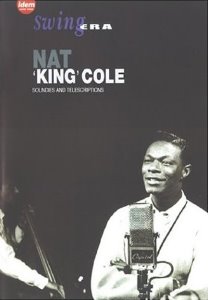 |
Cole is mainly known today as a singer, but he started out as a
highly influential and virtuoso jazz pianist who also sang, mostly
with a guitarist and bassist who rounded out his trio, on countless
novelty numbers with titles like, “Got a Penny, Benny?” Curiously,
he rarely looks at the keyboard while he plays his dazzling solos,
typically sitting in a position turned away from the piano and
towards the camera (and sometimes microphone), as if he were already
schizophrenically split between being a jazz musician and being a
pop vocalist. Sometimes bad dancers and other distractions
(including other vocalists) turn up, but usually it’s just Cole with
his trio, occasionally augmented by bongos and/or unseen strings.
(When it’s strings--as on the mushy final track “Always You,” the
only one in color—-the guitar and bass still appear briefly in
cutaways, but they’re completely extraneous, because no one’s
playing jazz anymore.) And in point of fact, some of the numbers
here are neither soundies nor transcriptions but clips from
low-budget features such as
Breakfast in Hollywood (1946) and
Killer Diller (1947) that were made for segregated black movie theaters.
My favorite tune here comes from the former—-the jivey “Solid Potato
Salad,” only about a minute long—-which begins with a driving piano
solo that might take your breath away. By contrast, on “Breezy and
the Bass,” a rare instrumental, which comes from the latter feature,
Cole’s occasional comps to bassist Johnny Miller are delightful,
affectionate little pokes.
|
 |
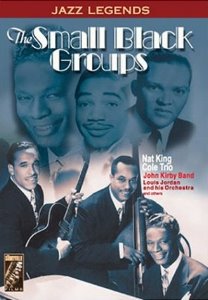 |
3)
The Small Black Groups. Both of these aforementioned Cole tracks and
seven others are included on this fascinating collection of 22
novelty numbers from the 1940s, taken from soundies as well as black
features. (Check out the insane zoot suits worn by two acrobatic
dancers in Louis Jordan’s 1944 “Jordan Jive,” with the musicians
appearing in soldiers’ uniforms.) The strangest by far are half a
dozen live performances by guitarist/ pianist/vocalist Slim
Galliard, the legendary composer of “Flat Foot Floogie”--celebrated
in Part Two, Chapter 11 of Jack Kerouac’s
On the Road as the essence
of jive, and seen performing here at Billy Berg’s club in 1946 with
his eccentric trio consisting of bassist and fellow vocalist “Tiny
Bam” Brown (often gesticulating and hugging his instrument at the
same time) and drummer “Scat Man” Crothers (best known today for his
part as the chef in Stanley Kubrick’s
The Shining, and offering
plenty of showy stickwork here).
|
|
Galliard was a hipster who liked to
attach “o’rooney” to the ends of his words—-an influential tic,
judging by Cole’s “Oh, Kickeroony” (also in
The Small Black Groups)—-and to chant the names of different kinds of Jewish food as
if they were mantras (as on “Dunkin’ Bagels,” also included); he
also turned up for cameos in Hellzpoppin’ (as part of the duo Slim
and Slam) and Too Late Blues (scat-singing at a party). The clips
here come from an obscure mid-40s musical called O’Voutie O’Rooney,
sometimes spelled O’Voutee O’Rooney, that I’d love to see unearthed
some day, if only to satisfy my curiosity. |
|
 |
|
4)
Jazz on a Summer’s Day. For any jazz buffs who find
themselves feeling starved at this point for color footage
of jazz musicians, apart from homogenized Nat Cole, the only film
ever made by still photographer Bert Stern (1960), chronicling bits
of the 1958 Newport Jazz Festival, will land you in some kind of
heaven. And the lineup includes Thelonious Monk, Louis Armstrong,
Eric Dolphy, Chuck Berry, Dinah Washington, Mahalia Jackson, Anita
O'Day, Gerry Mulligan, Chico Hamilton, and many others. The funny
part is, Stern--who wasn’t any sort of jazz buff, at least when he
shot this--passed up an opportunity to shoot Miles Davis at the same
event. But he sure knew how to make gorgeous use of color. And after
some distracting cutaways to boats in the opening sections of this
documentary, he eventually buckles down to an intense concentration
on the music and the audience's rapport with it as afternoon turns
into evening. Jackson's rendition of "The Lord’s Prayer" is a
particularly luminous highlight. Stern doesn't appear to know or
care what distinguishes mediocre from good or great jazz, or even
jazz from rock or spirituals, so all of these get some of his
attention. But he's very good at showing people listening, whatever
or however the music happens to be.
|
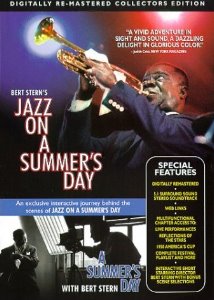 |
|
 |
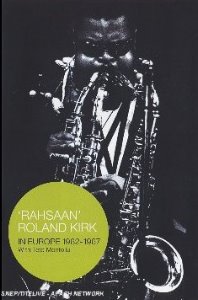 |
5)
‘Rahsaan’ Roland Kirk In Europe 1962-1967. Out of all
the great jazz musicians I’ve been lucky to see and hear live, one
of the few whose dynamic presence has almost never come through
adequately on LPs or CDs is Roland Kirk
--a commanding blind giant and demonic powerhouse whose New York
debut at the Five Spot in the early 60s was a kind of miracle. “He
makes Charlie Parker look like shit,” a friend hyperbolically said
to me at the time, and while I couldn’t come close to
agreeing—-neither of us had in fact ever seen Bird live—-the fact
that he said “look” instead of “sound”
helps to account for at least some of the hyperbole. Wearing shades,
Kirk typically lumbered up to the microphone with three separate
large saxophones hanging from his neck (two of them virtually
extinct instruments that he’d revived, the manzello and the
stritch), like the carcasses of felled animals, which he could play
all at once, in unison or in harmony, as well as a siren that he
liked to blow into curtly at the end of some choruses, which made
them function like giddy musical pivots--not to mention one or more
flutes stuffed into the bell of one of his saxophones. And once he
started to play, it was like being run over by a friendly
locomotive. |
Maybe it all sounds like it was a circus act, but Kirk used
everything at his disposal to make music, and the same applied when
he was simultaneously playing his flute and scat singing, with
periodic interjections from his nose flute—-to mention only one of
his other favorite orchestrations. All this is finally visible on
this DVD of two European concerts, both routinely shot in black and
white for TV. In Kirk’s 20 minutes in Milan (1962), the fact that
he’s playing with a relatively mechanical musician, Catalonian
pianist Tete Montoliu (who’s equally blind), is offset by the two
superlative beboppers rounding off the rhythm section, Tommy Potter
(bass) and Kenny Clarke (drums). And in Prague (1967), where he’s
backed by his own rhythm section and plays for 50 minutes, he’s
every bit as spirited.
|
 |
|
6)
Miles Davis Karlsruhe 1967. A 43-minute concert set with Davis,
Wayne Shorter, Herbie Hancock, Ron Carter, and Tony Williams. The
black and white image is grainy in spots
(and you can find lots of Miles in color, including music
videos, if you’re a fan of his electronic music), but
whoever shot this knew where to place the two cameras.
There are some striking moments in the up-tempo “Walkin’”
when we’re able to watch portions of Williams’ and Shorter’s solos
from two angles at once, deftly superimposed, and when Hancock’s
solo is briefly overlaid by Williams’ accompaniment. Musically, the
probable highpoint is the closer, “Gingerbread Boy,” which does
comparable pairings of Davis and Williams, Hancock and Hancock, and
Hancock and Williams. |
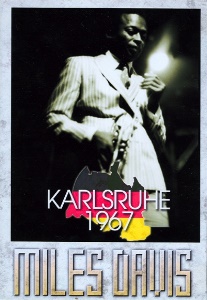 |

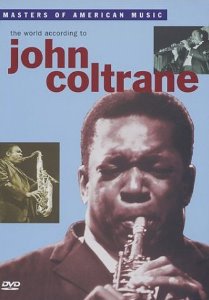 |
7)The World According to John Coltrane
and
8)
Trane Tracks
I was lucky enough to see Coltrane's classic quartet several times
in the 60s and was always amazed by his total relaxation amid the
cascading wails and yodeling fast runs that came out of his tenor or
soprano saxophone. He, pianist McCoy Tyner, bassist Jimmy Garrison,
and drummer Elvin Jones were completely absorbed, listening to one
another so intently that one couldn't help but join them, even in
noisy clubs. |
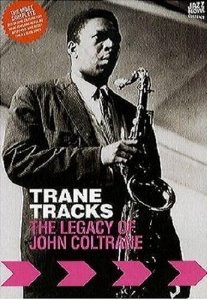 |
|
I only
have the second of these two excellent documentaries on
DVD, which mainly draw from the same pool of taped
performances, but both are smart enough to let these
play out at some length, without many interruptions. The
first, made by Robert Palmer and Toby Byron in 1992, is
about an hour long and begins routinely, but then takes
off once the filmmakers start cutting between still
photographs in sync with Coltrane’s “Giant Steps”.
I
haven’t been able to trace the director of the British,
80-minute
Trane Tracks: The Legacy of John
Coltrane,,
(2005), but can point to one special interactive feature
of the DVD: you can access the performances and
many of the interviews separately, and the songs can be heard in
more complete versions that way, without any cutaways or voiceovers.
There are two separate versions each of “Impressions” and “My Favorite Things” included; the second in each case has Eric Dolphy--playing alto sax on “Impressions,” flute on “My Favorite
Things”. But I’m especially taken with the extended, trancelike
Tyner solos on the first versions of these two songs.
|

|
9)
Johnny Griffin Quartet/Mike Mainieri Quintet: Modern Jazz at the
Village Vanguard. I hope I can be forgiven for concentrating
exclusively here on the half-hour Griffin set, which dates from 1981
and perfectly illustrates the following statement from this volatile
tenor sax player: “I like to play fast. I get excited, and I have to
sort of control myself, restrain myself. But when the rhythm section
gets cooking, I want to explode." There aren’t many rhythm sections
that cook more and swing harder than Ronnie Matthews (piano), Ray
Drummond (bass), and Kenny Washington (drums), and if someone wants
to argue that “Blues for Gonzi” and “56”--the up-tempo flag-wavers
that begin and end this set (with the more moderate “A Monk’s
Dream,” a third Griffin tune, sandwiched in between)--are taken too
fast, they should go right ahead and do so; but neither Johnny nor I
will pay them any mind.
|
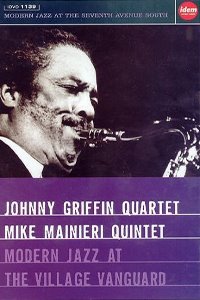 |

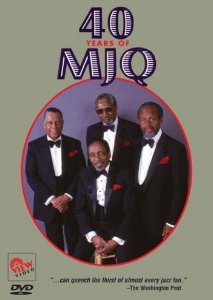 |
10)
The Modern Jazz Quartet: 40 Years of MJQ. Five years
before this 1992 concert in Stuttgart was released, the
MJQ’s 35th Anniversary Tour--another hour-long concert,
recorded in Freiburg—-came out. Ordinarily, I would have
opted for the
1987 DVD, which features the classic
quartet (John Lewis, piano; Milt Jackson, vibraharp; Percy
Heath, bass; Connie Kay, drums) without frills. This one
has Mickey Roker serving as temporary replacement for Kay, who was
ailing at the time, and also has Patrick
Strub conducting the Chamber Orchestra “Arcata” Stuttgart,
backing up the MJQ in Lewis’s own charts.
Paradoxically, this concert isn’t just more like
classical music; it’s also more like jazz. At both
events the aging quartet members in their tuxes look
rather like gravediggers, as they tended to do whenever
they performed together, but they’re in better form in
Stuttgart. |
|
The vibraharp is one of the few musical instruments that
it’s virtually impossible to play without dancing, and Jackson, even
in the reticence of his conserved energy, makes it all seem
completely effortless on both dates, but he swings more at the later
event, and you can see this in his body language as well as hear it
in the placements of his notes. And Lewis’s solos have rarely been
more brightly and brilliantly crystalline. Check them both out on
“Three Windows” (actually a suite of almost all the tunes used in
the MJQ’s soundtrack score for
No Sun in Venice) and “Sketch,” with
its great stop-time stretches. These are the first two numbers, and
if the remaining three are somewhat anticlimactic, that’s the down
side of achieving perfection. |

|
11)
Keith Jarrett Trio Concert 1996. It seems like all the Jarrett
concerts on DVD are class acts, so it’s hard in some ways to choose
between this one, recorded in Orchard Hall in some unnamed city (is
it Tokyo?), and the equally sprightly (and no less obscurely placed)
1993
Live at Open Theater East. The best track on the latter is
probably the very Milesian “Bye Bye Blackbird,” with a neat Gary
Peacock solo and a couple of triumphant cries of Jarrett towards the
beginning and end of the number that show just how wrapped up he
can get in the music. But I still prefer the 1996 date because of
what he manages to do with both “I’ll Remember April” and the
equally rhapsodic “Autumn Leaves”. “April” begins with a remarkable
drum solo by Jack DeJohnette; on this number, he manages to become
the de facto leader of the group with his fancy patterns, as
Jarrett’s near-ecstatic laughter at one point seems to acknowledge.
|
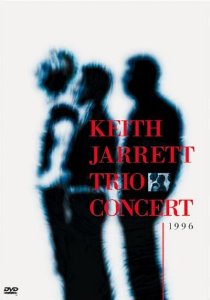 |
|
Jarrett’s own Jamal-like riffs and ringing, cascading lines seem to
grow directly out of this inspiration. The pianist’s habit of either
almost standing up when he gets carried away or, conversely,
retreating into a pretzel-like crouch, isn’t exactly a dance in any
normal sense; yet combined with the contorted facial expressions and
falsetto singing that accompany his solos, they suggest a feeling of
abandon that might be associated with dance or sex or something
equally unbridled. It’s all there in the music, of course, but
seeing as well as hearing it tells you at least a little something
about where it’s coming from. |

|











